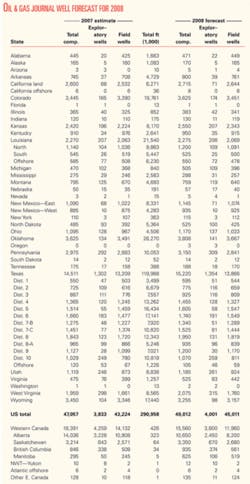Oil and gas drilling in the US will depend as much as ever on commodity price levels.
All indicators point to another drilling decline in Canada, but for now OGJ still forecasts a small uptick in drilling in the US.
Most operators project higher capital and exploration budgets for 2008, and those in the large multirig and mostly unconventional gas plays still foresee increasing the number of rigs they employ throughout the year.
Nevertheless, lingering price weakness could temper the optimism or even result in underspending if not outright cutting of budgets.
Here are highlights of OGJ’s early year drilling forecast for 2008.
- Operators will drill 49,012 wells in the US, up from an estimated 47,057 wells drilled in 2007.
- All operators will drill 4,001 exploratory wells of all types, up from an estimated 3,833 last year.
- The Baker Hughes Inc. count of active US rotary rigs will average 1,850 rigs/week this year, up from 1,768 in 2007 and 1,649 in 2006.
- Operators will drill 15,560 wells in western Canada, down from an estimated 18,391 wells in 2007.
Activity by state
As this forecast was being prepared in early January, the Baker Hughes rig count had fallen four straight weeks, ending at 1,774 after the week ended Jan. 4.
However, this was still 79 rigs higher than the count at the dawn of 2007.
OGJ looks for operators to drill 15,220 wells in Texas compared with an estimated 14,511 in 2007.
Wyoming seems to be the only state where a decrease seems certain this early in the year. Wyoming will host an estimated 3,255 wells drilled, which would be a 5.6% drop from OGJ’s 2007 estimate. The state’s oil and gas conservation commission said indicators there point to a drop in the number of coalbed methane wells and other gas wells drilled this year.
Oklahoma will see 3,808 wells drilled, up from 3,625 last year, and the estimate for Colorado is 3,625 wells compared with 3,445 in 2007.
Louisiana at OGJ’s estimate of 2,275 wells would be nearly unchanged from 2007.
US plays
Plays in the northern Rockies and even farther south may entice contractors to transport rigs that have lost work in Canada, and newbuild rigs will also contribute to the available US land rig fleet.
The Barnett shale play in Texas has sprawled from its core in Denton, Wise, and Tarrant counties to the noncore counties of Bosque, Clay, Comanche, Cooke, Ellis, Erath, Hamilton, Hill, Hood, Jack, Johnson, Montague, Palo Pinto, Parker, and Somervell, the Texas Railroad Commission noted. One company, Chesapeake Energy Corp., said it is running 38-40 operated rigs in the Barnett play (OGJ Online, Jan. 9, 2008).
East Texas, defined as the area from Tarrant and Robertson counties to the Oklahoma and Louisiana state lines, was responsible for 35% of the average Texas rig count in 2007. The area includes the eastern part of the Barnett shale play and other mainly gas plays in numerous Cretaceous and Jurassic formations.
The top two Arkansas Fayetteville shale players, Southwestern Energy Co. and Chesapeake Energy Corp., said they were operating 19 and 11 rigs, respectively, at the end of 2007. Southwestern alone planned to participate in 475 wells in the play in 2008.
Petrohawk Energy Corp., Houston, will shortly hike its Fayetteville play position to 150,000 net acres with the purchase of leasehold mainly in Van Buren, Conway, and Cleburne counties from a private seller.
Newfield Exploration Co. had 13 rigs running in the Arkoma basin Woodford shale gas play in December 2007, 11 of which were drilling development wells.
Pioneer Natural Gas USA Inc. announced plans to drill 350 oil wells in the Spraberry Trend of West Texas and 175 coalbed methane wells in the Raton basin in southeastern Colorado in 2008.
Canada’s outlook
OGJ’s estimate for Canada is more generous than that of associations north of the border.
The Canadian Association of Oilwell Drilling Contractors and the Petroleum Services Association of Canada in late October forecast a hefty 17% drilling decline to 14,500 wells in 2008. The groups’ expectations were already low before Alberta imposed a more onerous royalty regime.
Nearly 500 rigs were inactive in Canada in 2007, calculated Nickles Energy Group, greater than the number of available rigs 11 years earlier.
Nickles figures also show that 11.6% of the approved well permits in western Canada in 2007 were for oilsands evaluation wells.
Canadian operators are also limiting risk by drilling fewer exploratory wells. OGJ estimates that only 3,600 such wells will be drilled in 2008, down from an estimated 4,259 last year.



